|
Related FAQs: Agariciids, SPS
Corals, Stony/True Coral, Coral System Set-Up, Coral System Lighting, Stony Coral Identification, Stony Coral Selection, Coral Placement, Foods/Feeding/Nutrition, Disease/Health, Propagation, Growing Reef Corals, Stony Coral Behavior, Stony Coral Behavior, SPS Identification, SPS Behavior, SPS
Compatibility, SPS Selection,
SPS Systems, SPS Feeding, SPS
Disease, SPS
Reproduction,
Related Articles: True or Stony Corals, Order
Scleractinia, Dyed Corals,
/The Best Livestock For Your Reef Aquarium:
Cactus, Elephant Skin, Plate,
Lettuce Corals of the Family Agariciidae, pt. 4
To:
Part 1, Part
2, Part 3,
Part 5,
|
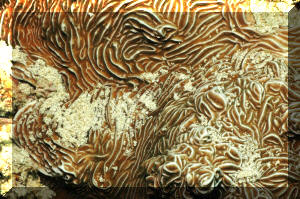
|
| Bob Fenner |
|
Genus Pachyseris Milne Edwards & Haime 1849, Elephant
Skin Corals. Many of the members of this genus display highly folded
colonies. These folds are concentric, parallel to the colony edge.
Never extend tentacles! /WA Corals: colonies laminar to encrusting • may
form broad upright columns • corallites are indistinct • obvious ridges form
parallel to the colony margin
There is some discussion re the family placement of this genus.
| Pachyseris gemmae Nemenzo 1955. Colonies
with numerous irregular folds. Photos, Cebu, Philippines and
at far right, N. Sulawesi. /COTW:
Characters: Colonies
have both horizontal and upright irregularly folded fronds. Valleys are
parallel to frond margins except towards the base of fronds where they
become irregular. Colonies are wavy. Columellae are wall-like and clearly
fused with septo-costae.
Colour: Brown.
Similar Species: May
be similar to tiered forms of Pachyseris
speciosa except that fronds are usually more vertical;
columellae are similar to those of P.
rugosa although less conspicuous.
Habitat: Semi-protected
reefs.
Abundance: Rare.
|
|
| Pachyseris rugosa (Lamarck
1801). Upright, irregular growth. Plates growing together.
Columellae as wall-like lobes. Massive sometimes in shallow water
to upright blades in deeper, calmer waters. Aquarium images. /COTW:
Characters: Colonies
are upright, irregular, usually contorted, anastomosing bifacial plates.
They are often over one metre across. Columellae are wall-like lobes.
Colour: Deep
bluish-grey or brown.
Similar Species: Pachyseris
gemmae. See also P.
involuta.
Habitat: May
develop into large mound-shaped colonies in shallow water but smaller
colonies occur in a wide range of habitats including those exposed to strong
wave action.
Abundance: Common.
|
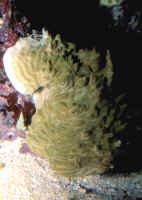 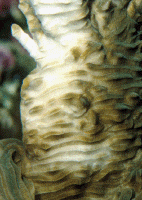
|
Bigger PIX:
The images in this table are linked
to large (desktop size) copies. Click on "framed" images
to go to the larger size. |
|
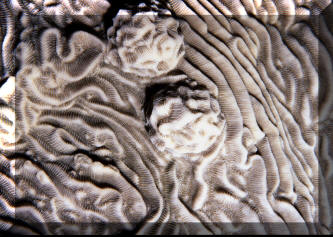
%20MD.jpg)
|
| Pachyseris speciosa (Dana 1846).
One sided colony faces, with regular ridging. Most common member of
the genus. N.E. Sulawesi image at right. Two in Fiji and a large colony
in the Red Sea below. /COTW:
Characters: Colonies
are unifacial laminae, usually horizontal, which may develop upright ridges
. They commonly form stands several metres across. More than one row of
corallites may occur between ridges. Columellae are absent.
Colour: Pale
brown to deep grey, often with pale margins.
Similar Species: Pachyseris
gemmae.
Habitat: All
reef habitats but most common on lower reef slopes.
Abundance: Common.
|
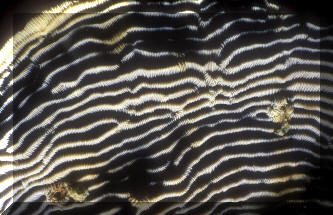
|
Bigger PIX:
The images in this table are linked to large (desktop size) copies.
Click on "framed" images to go to the larger size. |

%20MD.JPG) |
To:
Part 1, Part
2, Part 3,
Part 5,
|
|

